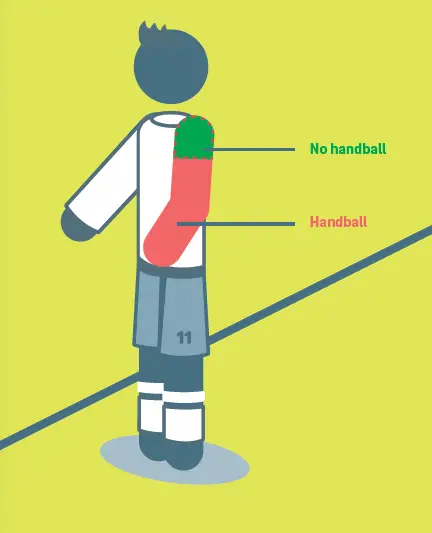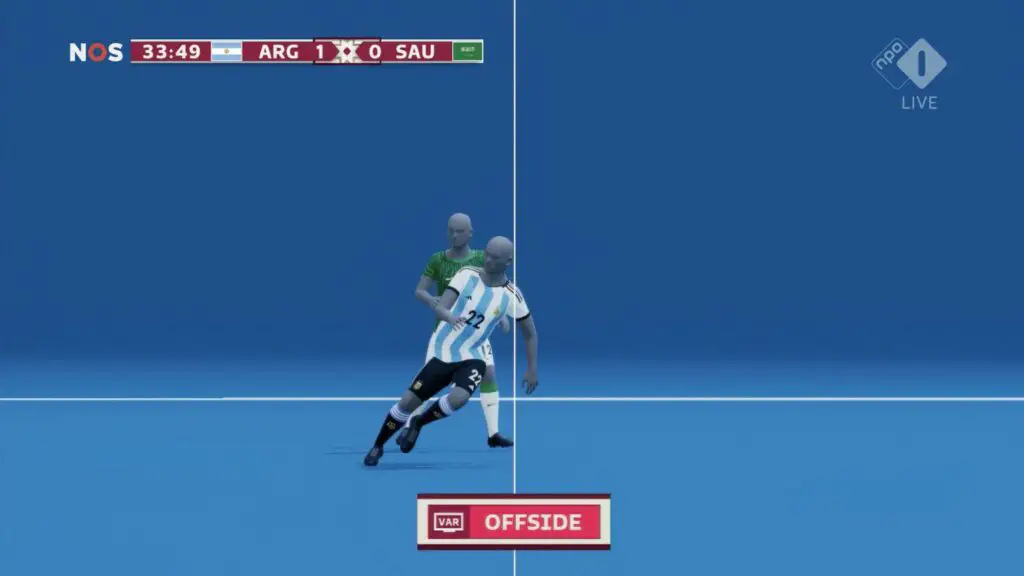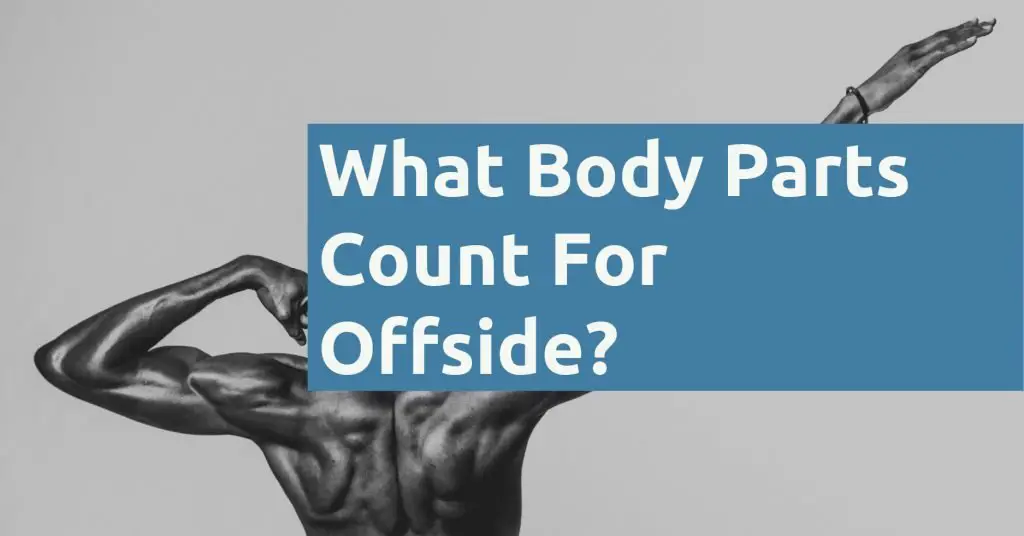Last updated on December 3rd, 2022
The offside rule can be rather confusing, especially when there are so many things to consider!
One of the minor details include the body parts that can lead you to be offside.
So which body parts will result in you being called offside?
Contents
- 1 What body parts count for offside?
- 2 Offside does not take into consideration your hands and arms
- 3 How does the IFAB define the arm?
- 4 The shoulder is different from the arm
- 5 Does the shoulder count as offside?
- 6 Does your arm count as offside?
- 7 Can you play someone onside with your arm?
- 8 Can a hand play you offside?
- 9 VAR controversy (the ‘armpit rule’)
- 10 Conclusion
What body parts count for offside?
The offside rule only applies to parts of the body that you are legally allowed to make contact with the ball. The only two body parts that cannot legally play the ball are your hands and arms.
Here is this rule explained in depth:
Offside does not take into consideration your hands and arms
To be called offside, you’ll first need to be in an offside position. According to the Laws of the Game, here is what being in an offside position means:
- Any part of the head, body or feet is in the opponents’ half (excluding the halfway line) and
- Any part of the head, body or feet is nearer to the opponents’ goal line than both the ball and the second-last opponent
- The hands and arms of all players, including the goalkeepers, are not considered.
The rule also includes goalkeepers, which may be applicable when he rushes out of his goal and becomes the second-last opponent.
The rule mentions that all body parts will be considered, except for your hands and arms. These are the only 2 parts of your body that are not taken into consideration when offside is being determined!
The referee will judge the offside position based on:
- The body part of the second-last opponent that can legally play the ball
- The body part of the attacker that can legally play the ball
If the body part of the attacker is closer to the goal-line, he may be considered as in an offside position. However, he also has to be ahead of the ball to be in an offside position!

The Premier League also mentions this:
The offside lines are drawn against the parts of the body of attacking and defending players that can be used to score goals. (These parts of the body are the same for all players, no matter their playing position)
One thing to note is that you will not necessarily be called offside if you are just in an offside position. You will have to become involved in active play, which could happen even if you didn’t touch the ball!
If you’re looking to stream the latest football matches from any location, you can check out the latest deals at NordVPN.
How does the IFAB define the arm?
Understanding what is the hand is easy. But what about the arm? How is it exactly defined?
Law 11 does not mention the definition of an arm. However, we can take reference to Law 12, which talks about handball.
A handball offence is committed when the ball touches a player’s hand or arm. The IFAB went one step further to clearly define what the arm is:
For the purposes of determining handball offences, the upper boundary of the arm is in line with the bottom of the armpit.
IFAB

This means that the armpit and your shoulder can legally play the ball!
This will also apply for the handball rule, which you can find out more about it here.
The shoulder is different from the arm
The offside rule takes into consideration the body part that can legally play the ball which is closest to the goal-line.
According to the handball rule, anything above the armpit can legally play the ball. This is because a handball offence will not be called if the ball hits that body part.
This means that both your armpit and shoulder are not considered to be part of your arm. If that is the body part that is closest to the goal-line, it will be used when considering the offside rule!
You can see this explanation by the Premier League website on a decision made against Raheem Sterling. The pictures show that his armpit was being used as the point of reference, even though his arm was ahead.
This video also shows how the lines are being drawn for the attacker and the defender. Even though Roberto Firmino’s arm is ahead, his shoulder (or armpit) is being used to draw the line too.
Here are some answers to certain questions regarding this part of the offside rule:
Does the shoulder count as offside?
The offside law only excludes the hand and arms from being considered. Your shoulder is defined to be separate from your arm. As such, your shoulder will be taken into consideration if it is the body part closest to the goal-line.
If you are the ‘second-last opponent‘, the offside line will be drawn at your shoulder. This will occur if your shoulder is the body part closest to the goal-line.
Even if your hand or arms are closer to the goal-line, only your shoulder will be considered.
However, the lower boundary of the arm (in line with the armpit) is considered as a body part that can play the ball.
In this extremely tight call between Belgium and Croatia, it was seen that the Croatian player’s sleeve was just slightly ahead of the Belgium player!
This was an extremely close call as it really depends on how you define the sleeve and the arm, especially since it’s really hard to decide which part of the arm is in line with the armpit.
Does your arm count as offside?
Your arm does not count as offside as it is not considered when the referee determines the offside position. Your body part that is closest to the goal-line (excluding the hands and arms) will be used to draw the offside line.
Here is a video to explain the different scenarios.
The above video shows that the attacker’s hands and arms are past the defender’s offside line. However, only the boot will be considered.
This is because the boot is the body part that can legally play the ball and it is closest to the goal-line.
If the attacker’s head was closer to the goal-line as he leaned forward, his head will be used instead. This is because only body parts that can legally play the ball will be considered during an offside call.
Another example is the World Cup match between Argentina and Saudi Arabia, where Argentina’s players were called offside multiple times.
For one of these calls, Lautaro Martinez’s arm was much further offside. However, the point of reference was only taken at his shoulder, which was ahead of the second-last defender.

You can find out how the offside rule applies when the ball is past the last defender here.
Can you play someone onside with your arm?
You cannot play someone onside with your arm. This is because the referee will not consider your hands and arms when making an offside call. The body part that is nearest to the goal-line will be used instead.
Can a hand play you offside?
A hand cannot play you offside. Your hands and arms will not be used by a referee to determine your offside position. The body part (excluding your hands and arms) that is nearest to the goal-line will be considered instead.
VAR controversy (the ‘armpit rule’)
Offside used to be less contentious when it was just based on the referee or assistant referee’s decision. This was because it was very hard for them to make a decision on very tight calls.
However, with the introduction of the Virtual Assistant Referee (VAR), the way offside is determined has changed.
This is because the VAR is able to make a call based on the finest margins.
For example, here is a goal scored by Patrick Bamford which was ruled offside. When you look at the replay, you can see that his armpit was marginally closer to the goal-line compared to the defender!
Technically, this is correct under the law. Bamford’s armpit can legally play the ball. This is because his armpit cannot commit a handball offence.
However, the decision can be somewhat ridiculous!
Hopefully, the rules will be modified to allow for some leeway for these tight calls!
Conclusion
When an offside decision is made, the body parts of the second-last opponent and the attacker will be compared.
If the attacker’s body part is closer to the goal-line than the defender, he will be called offside.
However, the hands and arms of both the attacker and defender will not be considered in the offside call. If the hands or arms are the body part that is furthest ahead, the next furthest body part that can legally play the ball will be used instead.
This includes your shoulder, and more controversially, your armpit!
You can find out more about why we need the offside rule here.
If you’re looking to buy the latest football merchandise from your favourite club, you can check out the latest deals at Kitbag.
Subscribe to Telegram and Twitter to get the latest updates!

Are you passionate about football and want to earn some side income?


